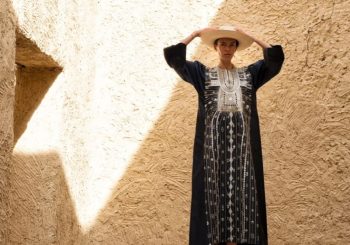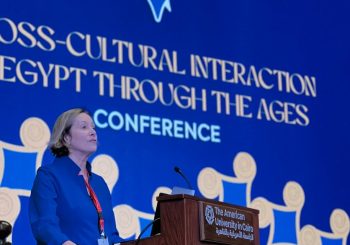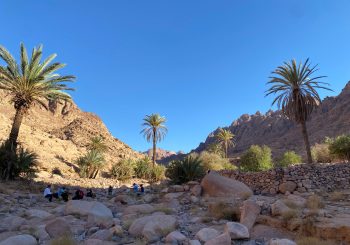Surrounded by a freshly-mowed lawn and a high wall in a serene area of the Manshiyat el-Bakry neighborhood in Cairo’s Heliopolis, stands the villa that once housed the late Egyptian president and Arab nationalist icon Gamal Abdel Nasser.
Just over a year ago, after years of bureaucratic haggling, delays and renovations, the two-storey villa was opened to the public after having been turned into a museum.
The house, with its cream-colored exterior and modernist architectural style, is a living memory of the man, who in the eyes of many Egyptians, not only brought about a large-scale modernization of the country and the dismantling of monarchical rule, but also pushed it to the forefront of the global struggle against Western imperialism.
The property, which was bought by Nasser before his Free Officer’s Movement overthrew the British-backed king in 1952, was originally a single-storey house. As the Egyptian leader gained in status and popularity, it was further extended to include a second storey.
Upon entering the villa, one is immediately struck by the grandiose space of the reception hall, with its high ceiling, marble floors and large classic photographs of Nasser displayed on the walls.
In an exclusive interview with Egyptian Streets, the architect and designer of the museum, Karim Shaboury, says that every little detail in the design process is intended to convey a message to the audience.
Immediately upon walking into the building, one is met by this grand open space with Nasser gazing down on you from above, conveying a feeling of power and significance.
“Once entering the museum you can see the big-scale banners with the figure of Nasser. Such an element transmits a message that says that this figure is an important person without [explicitly] saying ‘Nasser is important,’” says Shaboury.
The reception area houses three doorways, representing three different typologies, or tracks, of exhibits that the museum is made up of. The first is dedicated to the personal living and working area of Nasser and his family. The second displays the historical developments of Egypt under his rule, where one can view a host of exclusive archival material. The third track shows the president’s personal belongings, including medals of honor and gifts received from foreign dignitaries.
For visitors, the first track is arguably the most exciting. Here one is invited to immerse oneself in the spaces that made up Nasser’s private life. The ambient lighting spurs the imagination of Nasser’s presence, how he used to move through the rooms, how he sat on the 1960s-style furniture, spent time with his family and pondered upon matters of state.

According to Shaboury, it was important to capture the atmosphere and mood of a private home in order for visitors to have a fully immersive experience.
“We wanted to present or transmit the feeling of the coziness of the house, the privacy. So for example in his bedroom, you will see the lighting coming through the small units around his bed, or on the desk in his office. So here we were trying to recreate the feeling of intimacy [of] the private space […] The house now is not inhabited so if you don’t feel the presence, the spirit of presence of inhabitants, you won’t get emotional with space,” he says.
An Egyptian architect of Alexandrian descent, Shaboury was in 2004 awarded the Egyptian State Prize for Creativity and Innovation in museum architecture and museography. He received his Master’s degree in Museography, Architecture and Archeology from the University of Rome in 2010 and now runs a consultancy firm specializing in museum design.
His firm being the only one he is aware of in Egypt that specifically specializes in designing museums, he emphasizes that there is a lack of knowledge in the country regarding the fact that creating high-quality museums requires specialist competence.
Egyptian museums, perhaps with the exceptions of the Grand Egyptian Museum and the Bibliotheca Alexandrina, are often considered to be lacking in quality. The dearth of professionalism and expertise within the field of museum design and museography has contributed to the arguably low standards of museums here, Shaboury says.
With a few exceptions, “there are no universities [in Egypt] that have a museum studies department […] in terms of professionals, […] professors, professional museologists, professional curators, professional collection managers, professional designers and museographers, we don’t have that kind of people.”
Due to the lack of expertise, he himself had to take on the responsibility of doing what other specialists would have done when he designed the Nasser museum.
“I was lucky that I had full authority to do the museum the way I wanted so I had to fill these gaps by doing the job that should be made by a curator or a collection manager.”

“In other museums in Egypt, the problem is that they don’t know precisely [how to create high-quality exhibitions]. Maybe they have an intention to do a good museum, but they don’t know the process, they don’t know the calibers that should be involved,” Shaboury told Egyptian Streets. He adds that he believes there needs to be a restructuring of the process of designing and creating content for Egyptian museums.
Back in the museum, as most of the rooms are open for visitors to enter, they are invited to truly experience these spaces, the interior of which has not significantly been altered since the time Nasser and his family lived there.
“There were no major changes except for some technical issues that we had to consider […] but as a look and feel of the space they are preserved as they were.”
The Nasser residence, where personal effects such as family photos and a cigar cabinet with the inscription “from Fidel Castro” are displayed, not only evokes memories of a gone by era, but also helps humanize a character who has been endlessly mythologized by Egyptians and foreigners alike.

In 1952, Nasser grabbed power through a military coup which would be the beginning of Egypt’s republican era.
His vision and dream were to free Egypt from the yoke of British colonialism and rebuild the country – politically, economically, socially and culturally – based on semi-socialist principles.
A nation-wide industrialization project and large-scale land reforms, that saw the redistribution of agricultural land from land-owners to farmers, immensely increased Nasser’s popularity among the country’s workers and peasants.
However, he also outlawed political parties, tightened the state’s grip on civil society and put thousands of communists and other regime critics in prison.
His end as the leader and icon of the Arab world came with Egypt’s defeat by Israel in the 1967 war that led Nasser to publically announce his resignation from the presidency.
Nasser’s announcement was however followed by millions of Egyptians taking to the streets demanding his return.
Heeding the call of the people, Nasser continued ruling the country for three more years until his death of a heart attack in September 1970.
His funeral witnessed one of the largest gatherings of people Egypt had ever witnessed and, to this day, the legacy of the president remains inscribed in the nation’s memory.
Behind the headlines and political drama, a man with modest beginnings yet bold ambitions emerges from the museum created in his honor.
Despite the fact that Nasser has been a symbol of the state which would perhaps have invited officials to comment on the process of designing the museum, Shaboury says he had free hands to do whatever he liked, without intervention.
“Usually this kind of museum presents the official story on the state level but […] maybe I was lucky in this museum, there was no intervention in what I was doing. Actually, I had complete freedom in creating the content.”

However, he stresses that the period following the 2011 uprising was challenging in terms of ensuring that the changing governments would not influence his team’s work on the museum.
“For instance, after the revolution, when the Muslim Brotherhood was in power, they were totally against Nasser so we had a fear that this would have a negative effect on the project. At the same time, after June 30 [2013] when the new [Abdel Fattah al-Sisi] regime came, which took power in a similar way as the regime of the 1952 revolution, we also had a fear that the museum would be used for political purposes or propaganda purposes.”
Moving into the topic of the general status of museums in Egypt, in response to a question of whether the Nasser museum represents a break from a trend whereby the state has not taken much interest in producing museums of high quality, Shaboury refutes that claim.
He says that although there are some exceptions, “from the state’s side, I can’t see [a break from the trend]”.
Although Karim Shaboury and his team encountered some bumps on the road to establishing the museum of the late Egyptian president, he underscores that what is important for him is that the museum ultimately was successful.
He stresses that Egypt should take more care to appreciate its rich history, and through the creation of high-quality museums, such as the one he designed, people can experience the country’s past in a direct and engaging way.

Photos Courtesy of Nour El Refai







Comment (1)
[…] 3- Inside the Historic House Museum of Gamal Abdel Nasser […]